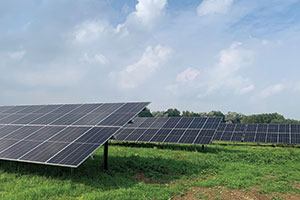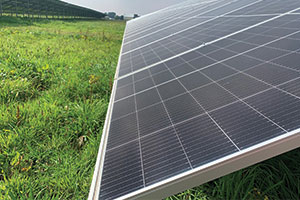5 golden rules for solar diversification
Robert Barker from Centrica Business Solutions (sister company of British Gas) outlines five golden rules for making a success of diversifying in to solar
Choose your partner carefully
Solar farms will typically have a lifespan of around 40 years, so you need to ensure that your chosen partner is likely to be around for the long term.
Once a lease option is signed, the developer will start investing seriously in terms of time and money into the project. Normally grid connection will be secured and will require the developer to begin making payments, at this point it will be very difficult to switch to an alternative developer, so don’t allow the developer to enter into the grid connection agreement until the option agreement has been signed for your land.
It’s quite common for solar farms to change hands and be sold to investors. If this is something that worries you then do your homework and ask the question right at the start of the development process. Do you want to select a partner who is going to develop the project and then sell it on, or is it more important to work with an organisation that will undertake the development and hold the asset and obligations for the long term?
Keep your local community onside
Rightly or wrongly, solar development remains a divisive subject and while most people will be supportive of the role that they play in tackling climate change, a minority may see them as damaging the landscape.
So, early discussion of the plans with the local community is important and a serious developer will support you in this and will take-on board local concerns. Again, ask how this will be handled of any potential partner, this decision will have consequences on how likely you are to get consent for the plans.
A good grid connection and the right topography are key
A solar farm or energy storage site will require a 33kV grid connection (as a minimum) with spare capacity in that part of the network. In much of the UK, suitable grid capacity is increasingly difficult to obtain.
As a developer, we employ grid experts to identify suitable grid connections and investigate what options might be available to make the site work.
If you have a suitable grid connection on your land this makes the project much easier as no third-party wayleaves and access agreements are required.
Site topography is also important. This will impact the capital investment required, the site performance and the long-term maintenance costs.
We would ordinarily try to minimise the footprint of the solar array, as spreading panels out over a wider area leads to energy losses and higher maintenance costs, it also means you lose more land that could be used for agricultural purposes.
Flat sites or gentle southerly sloping sites are ideal for maximising generation performance.
Investment cases can be finely balanced
Solar energy projects are generally very low-risk for the landowner, who will have a 40 year secure revenue stream from the land rental. Solar doesn’t preclude farmers from using the land for some livestock grazing and there can also be benefits for biodiversity enhancement of the farm.
 But whether a farm solar project is commercially viable for the development partner is heavily impacted by a combination of specific site factors – namely the suitability of the land, cost of the grid connection, the land rental sought, the energy market revenues and the capital cost of the technology.
But whether a farm solar project is commercially viable for the development partner is heavily impacted by a combination of specific site factors – namely the suitability of the land, cost of the grid connection, the land rental sought, the energy market revenues and the capital cost of the technology.
Landowners have the ability to influence two of these factors and therefore the viability of the project. A combination of solar and battery storage can help to maximise energy market revenues – as it opens up more markets for the power generated on the site.
But, the balance of risk lies firmly with the development partner, who at the end of the process is obligated to return the land to its former state. Land rental levels are likely to reflect the low-risk nature of the investment for the landowner, it’s not a get rich quick scheme, but increases revenue diversity for the farm.
Act quickly
Securing a cost-effective grid connection is key to a successful renewable energy project. In 6 months’ time the grid connection that is available today may no longer be viable, and the farm solar project opportunity will be gone.
For more information about Centrica Business Solutions and how they can work with you, please visit: https://www.centricabusinesssolutions.com/our-business/centrica-energy-assets
- Log in to post comments

